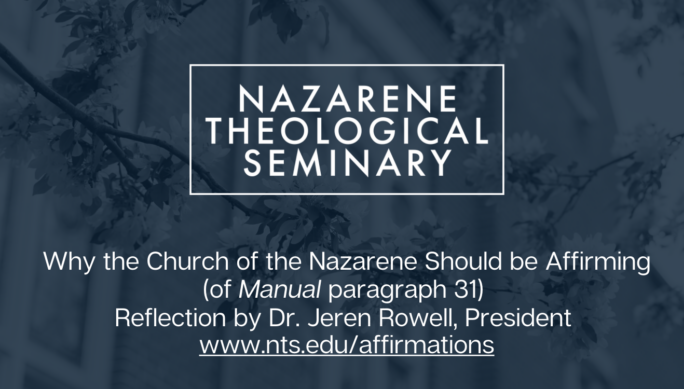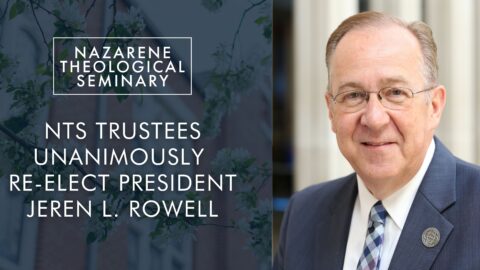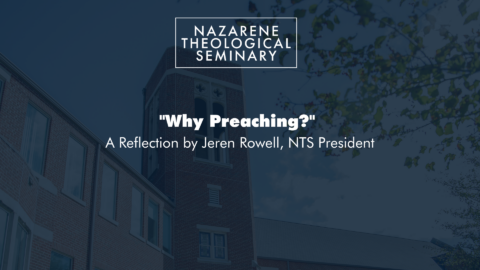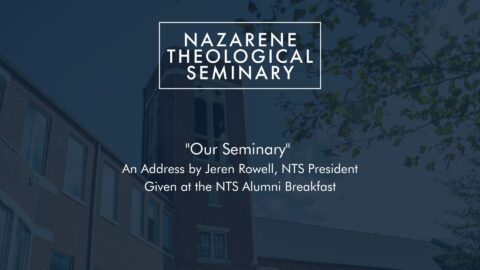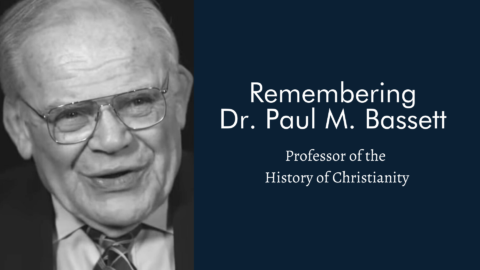Soon, members and friends of the Global Church of the Nazarene will gather in Indianapolis, Indiana (USA) for the holy work of Christian conference. True Christian conference does not happen simply because we call a meeting that people attend. Christian conference happens as a work of the Spirit who gathers us, nourishes us in holy love, and sets us to the work of being the body of Christ in the world.
This is how we should be praying for the 30th General Assembly. Let us pray earnestly that God, in mercy, will gather us in love by the power of the Holy Spirit, that we might lift the name of Jesus, our Redeemer. Pray that we will come together in humility, with a commitment to be “quick to listen, slow to speak, and slow to become angry” (James 1:19).
One of the issues that seems to have overwhelmed much of our conversation since our last assembly is the important matter of human sexuality. The 29th General Assembly approved what is now paragraph 31 of the Manual of the Church of the Nazarene. Recognizing that there are some voices in the Church calling us to change our understanding of human sexuality, I am compelled to offer my convictions and hopes for how we continue to address this important matter. I also offer my heartfelt plea that we will do this hard work from a posture of unified love and grace, confident enough in the Spirit’s faithful work that we can make room for one another as we seek “the unity of the Spirit through the bond of peace” (Eph. 4:1).
While I have in mind recent writings that explicitly call for the Church of the Nazarene to become affirming of same-sex marriage, I intend this offering as more than counterpoint or reaction. Some who are articulating this call are friends whom I love. My disagreement with their position does not allow me to dismiss them from my care. I am called to listen, dialog, and maintain fellowship with them as sisters and brothers in Christ Jesus. We simply must refrain from making enemies of one another in the body of Christ.
Affirming God’s Design
I do not think or believe that the Church of the Nazarene should become affirming of same-sex marriage. Most Christians appeal to the Bible to support their position on this matter, and many other matters. This is a good impulse, unless the appeal to Scripture is done in ways that betray our Article of Faith on The Holy Scriptures (Article IV). Nazarenes do not embrace a “flat” reading of scripture which becomes literalistic and devoid of interpretive discernment. The most important way to appeal to Scripture is to have in view the whole story of God which is revealed to us in the Word (Jesus Christ) as the Bible bears witness to God’s revelation.
The worst way to appeal to the Bible here is through conversation-ending quotations of the six Bible texts that specifically mention homosexual practice. These texts are not only debated in terms of interpretation and application, but they are also not sufficient in themselves to proclaim the theological foundation for the affirmation of heterosexual marriage as the exclusive arena for sexual intimacy.
This is certainly not to suggest that the six Bible texts1 do not belong in the conversation, they do belong. Nevertheless, a more robust theological grounding is the whole story of God’s good creation as reflective of the nature of God’s love, from Genesis and the Garden of Eden to Revelation and New Creation. God’s design for the male/female union must be seen as more than a pragmatic device for fulfillment of the “be fruitful and multiply” command (Gen. 1:28), but also as paradigmatic of the holy community of love (Father, Son, Spirit) which of its nature is self-giving and bursts forth into life-giving creation.
This affirmation does not necessitate the false assumption that celibate persons, whether single heterosexual or same-sex oriented, are experiencing something less than fullness. Jesus is the most complete, fulfilled human ever to walk the earth. Wesley Hill, writes, “The life of Jesus dislodges our assumption that having sex is necessary to be truly, fully alive.”2 Many others embrace celibate life with joy and fulfillment. And the fullest expression of the holy community of love, this side of fully realized new creation, is the body of Christ, the church.
We see the mysterious connection between marriage and the church expressed by Paul in Ephesians 5:31-32, drawing from Genesis 2, which was also done by Jesus (Matt. 19:5). And, as noted by Janet Dean, “This sacred image of marriage not only occurs in the first pages of Scripture, but also in the last as we look toward the ultimate marriage bringing together the Lamb of God with His bride, the Church (Rev 21:9-11).”3
In these significant New Testament connections between creation, marriage, and new creation, Jesus, and Paul, recognize that questions about the covenant of marriage (divorce, authority, submission) cannot be answered sufficiently from the law, nor from what we might now call psychological or sociological resources alone. Reflecting on the Matthew 19 text, one scholar writes, “While Pharisees asked about divorce, citing the law code, Jesus answered about marriage, citing the creation story. Jesus shifted the question, from legality of divorce to theology of marriage.”4
The witness of marriage is not only to the love shared by two people, but also, and perhaps most essentially, it witnesses to what it means for human beings to be image bearers of God. Roger Hahn notes that “in the characteristic parallelism of Hebrew poetry, the phrase, ‘the image of God’ [in Genesis 1] appears in parallel to ‘male and female.’” Thus, “sexuality (genderdness) is part of what it means to speak of human beings created in the image of God.”5
This affirmation does not in itself necessitate the conclusion that only married persons have capacity to bear God’s image. The image-bearing of humanity is most essentially in reference to the whole of humanity, and particularly to the body of Christ, the church. Therefore, single persons can live God-bearing lives, participating fully in the image-bearing work of humankind.
Why Male/Female?
It is evident that the biblical creation narrative features the inclusion of boundaries to enable the thriving of humanity in God’s good creation. These boundaries are set largely through distinctions between corresponding pairs: day and night, heaven and earth, evening and morning, sea and sky, water and dry land, sun and moon, etc. The pinnacle of this divine ordering comes in the imago Dei (image of God) creation of humankind, which is particularly expressed as male and female, created for covenantal love and shared stewardship of a flourishing garden.
The correspondence of male and female is consequential to the purpose for marriage as expressed in Genesis 2:24, where the relationship of man and woman is “a relationship of commitment and devotion that forms a living entity of its own.”6 This male/female union is part of God’s creation, not a pragmatic afterthought, which enables an ongoing enactment of self-giving love which brings forth life. This is not to deny that the notion of gender may be more complex than a simple binary.
However, there is no continuation of humankind outside of male/female union, even when this is accomplished through technological means. This is simply to affirm that male/female is not incidental, but essential to God’s creative design. It is my conviction that same-sex orientation or desire is not God’s design nor God’s gracious and loving accommodation of human development. Same-sex orientation is one expression, among many expressions, of the brokenness that sin brings into God’s good creation.
This may be a hard word for followers of Jesus who experience same-sex attraction. I also recognize the reality of persons who experience gender dysphoria or are intersex. My affirmations are offered without intent for harm toward loved ones who identify as LGBTQIA+ or toward others who believe that the Church should become fully affirming of same-sex marriage. I recognize that simply saying so does not in itself mitigate the harm, so I offer charitable conversation to anyone who may want to offer alternate views.7
The brokenness of a fallen world because of sin is both general (the dis-ease of creation) and particular (disordered desires that all humans experience in various ways). Specifically, when we speak of brokenness in terms of human sexuality, all of us are included. Being in a monogamous, heterosexual marriage does not in itself prevent one from experiencing the brokenness of sin in our sexuality. The lifelong journey of marital intimacy is about learning ever deepening lessons of self-giving for the sake of the other. Along the way, none of us are flawless and all need to embrace a humble posture of mercy and forgiveness.
Rule of Faith and Practice
My intent with the above is primarily to ground this important dialog theologically, which means that the Scriptures must figure prominently. As Wesleyans, we affirm the centrality of Scripture as the source for Christian doctrine and practice. Closely connected to the work of biblically based theological discernment is the work of attending faithfully to the witness of the church through history.
Christian tradition is a critical and complementary resource for the interpretation of Scripture. While Christian tradition does not share in the same authority as Scripture for the life of the church, the confessions of the church “are indeed the church’s hermeneutic for the interpretation of Holy Scripture.”8
One of the important contributions of the late Wesleyan theologian, William J. Abraham, was to articulate the conviction that the church is formed as an act of the Holy Spirit who works not only with the revelation of God in Jesus Christ as given to us in Holy Scripture, but also with the gifts of Christian tradition including liturgy, sacraments, creeds, councils, teachers, and more.9 While Christian theology is an ever-dynamic work of “faith seeking understanding,” it is also attentive to the wisdom of the church through the centuries and is not too quick to discard tradition in the name of innovation or enlightened development.
We understand the work of Scripture interpretation as drawing together complementary resources of tradition, reason, and experience. This sometimes misnamed “quadrilateral” does remind us that we do our interpretive work not in a flat, literalistic manner, but within the gifted resources of philosophy, science (including social sciences), testimony, and church tradition to arrive at faithful teaching and Christian nurture.
The current conversation regarding human sexuality is, in my view, privileging reason and experience significantly over scripture and tradition. We love people who are expressing their sense of identity as same-sex oriented. We know that God is love (a theological affirmation) and loves all people, therefore, should not our God-inspired love for all people include acceptance of their sense of self? One well-respected Christian writer and speaker declared part of his reasoning for becoming affirming as, “I just know too many wonderful Christian people who are in gay relationships.” While I recognize and appreciate the love that is no doubt behind this declaration, I find it a wholly inadequate basis from which to construct an affirmation of same-sex relationships. Widely held values like justice and fairness may seem sufficient for this affirmation, perhaps even loving in a general way. However, disconnected from revelation and biblical theology, these good impulses can begin to serve the contemporary god of self-actualization or individual sovereignty.
What Nazarenes Should Affirm
The matter of human sexuality is much larger than homosexuality or same-sex marriage. We should strongly affirm what Manual paragraph 31 affirms: “. . . sexuality [as] one expression of the holiness and beauty that God the Creator intended.” And “Our bodies are good, very good.”10 These are simple but critical and often neglected affirmations that call the Church to become intentional about discipleship regarding how we embody our faith.
Part of Christian hospitality includes the creation of safe spaces for difficult conversations. Our schools, rather than being targets of criticism for hosting these conversations, should be supported, while being held properly accountable. It is possible to do both if we are truly in relationship with one another in the spirit of holiness. And the movement toward “inquisition-style” attacks on faculty and some in the ordination process are not in the spirit of holiness as they escalate fear and preclude wise and patient responses to applications of our faith.
We should especially and strongly affirm that the body of Christ must “be a welcoming, forgiving, and loving community where hospitality, encouragement, transformation, and accountability are available to all.”11 Perhaps the main barrier the Church experiences in this matter is not so much our theology of human sexuality but our failures to live as a loving community, too often reaching to the ways of an anxious and angry world.
Let us repent from every way that our anger leads people around us to believe that the church is nothing more than hateful “homophobes” who want to elbow gay people out of not only any meaningful connection to the church but also from basic civil rights that are constitutionally offered to all within a democratic society. We should affirm Manual paragraph 31 which states: “The body of Christ should always be a place of justice, protection, and healing . . .”12
Pride and self-righteousness have no place in the life of holiness, including in our attitudes around the complexities of human sexuality. The truth is that all of us experience in various ways the painful reality of sin’s impact on one of the most intimate aspects of our humanity. As we do the hard work of discernment around these matters, all of us should be willing to confess and repent from all forms of sexual brokenness. “Let anyone among you who is without sin be the first to throw a stone” (John 8:7).
The words of Darrin W. Snyder Belousek are poignant and prophetic:
The more we can recover a vision of sexual holiness that exposes all of us, without exception, as in need of forgiveness, liberation, and sanctification and that beckons all of us, without exception, into a lifelong process of having our desires confronted, challenged, and transformed by the love of God in Christ, the closer we will be to approaching the life mission and message of Jesus Christ.13
There are some current voices insisting that a truly transformed believer in Jesus Christ cannot testify to any sense of LGBTQ self-awareness or identity, even as they testify to Christlike discipleship. This kind of insistence is unnecessary, potentially harmful, and it is contrary to what the Church of the Nazarene has affirmed for many years:
The person who is homosexually oriented does not need a church that condemns their orientation, but rather a church that calls for a response that is in keeping with the character of God. The church should not be a place of ridicule and condemnation, but a place of love, of grace, and of redemption.14
Even as we negotiate our differences of viewpoint in this important conversation, we could advance the cause of Christ considerably by forsaking gossip, slander, and malice toward one another. Too many of our own children are walking away from their spiritual heritage because of the toxic atmosphere that we have sometimes allowed to overshadow the bright and hopeful message of holiness. If we truly believe what we say we believe, then “perfect love casts out fear” (1 Jn. 4:18).
Nazarenes, let us not grasp for control through the ways and means of this world, but let us embody the fruit of the Spirit: “love, joy, peace, patience, kindness, goodness, faithfulness, gentleness, and self-control” (Gal. 5:22-23). Let gospel truth not be wielded as a destructive hammer, but as a healing balm for the wounded and weary. May the grace and peace of our Lord Jesus draw us together in unity.
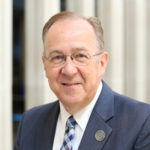
Dr. Jeren Rowell
President and Professor of Pastoral Ministry
References
1 Genesis 19:1-29, Leviticus 18:22; 20:13, Romans 1:18-32, 1 Corinthians 6:9-11, 1 Timothy 1:10.
2 Hill, Wesley. Washed and Waiting: Reflections on Christian Faithfulness and Homosexuality. Zondervan, 2016, p. 95. Hill is Associate Professor of New Testament at Western Theological Seminary.
3 Dean, Janet. “Who Am I?”, unpublished paper, 2022, p. 2. Dean is Professor of Pastoral Counseling at Asbury Theological Seminary.
4 Snyder Belousek, Darrin W. Marriage, Scripture, and the Church. Baker Academic, 2021, p. 30. Belousek is Professor of Philosophy at Ohio Northern University.
5 Hahn, Roger, “Toward a Theology of Sexuality,” unpublished paper, 2017, p. 4. Emeritus Professor of New Testament at Nazarene Theological Seminary.
6 Hahn, p. 9.
7 Many of these are now offered in a newly released book, Why the Church of the Nazarene Should be Fully LGBTQ+ Affirming by Thomas J. Oord and Alexa Oord, eds.
8 Noble, T. A. Holy Trinity: Holy People: The Theology of Christian Perfecting. Cascade Books, 2013, p. 9.
9 Abraham, William J., et. al., ed. Canonical Theism: A Proposal for Theology and the Church. Eerdman’s, 2008.
10 2017-2021 Manual of the Church of the Nazarene, paragraph 31.
11 Manual 31.
12 Manual 31.
13 Snyder Belousek, Ibid, p. 295.
14 Board of General Superintendents, Pastoral Perspectives, 2010, p. 10.
Further Reading
- Boone, Dan. Human Sexuality: A Charitable Discourse. Trevecca Press, 2022.
- Church of the Nazarene, Board of General Superintendents. “Pastoral Perspectives from Your General Superintendents on Homosexuality” (2010). Scholarship – President’s Office. 2.
- Snyder Belousek, Darrin W. Marriage, Scripture, and the Church. Baker Academic, 2021, p. 30.
- Tennent, Timothy. For the Body: Recovering a Theology of Gender, Sexuality, and the Human Body. Zondervan, 2020.

